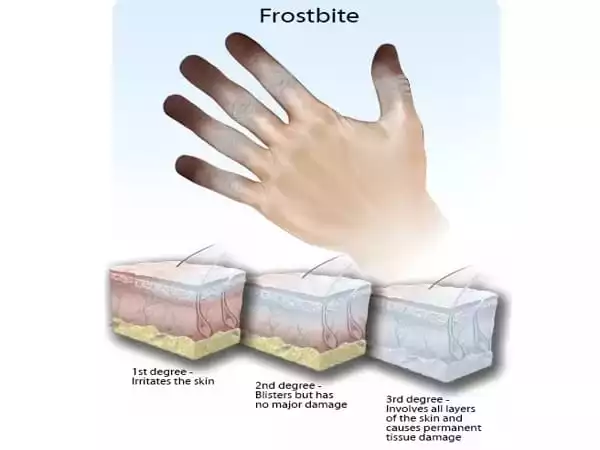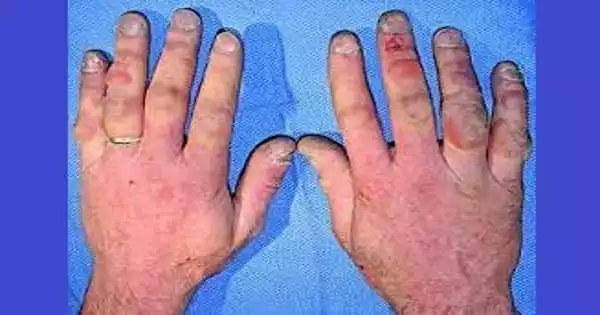Frostbite is a skin and underlying tissue lesion induced by freezing. There is no permanent skin damage in the early stages of frostbite, known as frostnip. Cold skin and a prickling sensation are common symptoms, followed by numbness and irritated or discolored skin. As frostbite progresses, the skin may become hard or waxy in appearance.
Frostbite is most common on exposed skin in cold, windy conditions, but it can also occur on skin covered by gloves or other clothes. You may be unaware that you have frostbite until someone else points it out to you.
Skiers, hikers, warriors, and anyone who are exposed to extremely cold conditions can develop frostbite, a painful injury caused by the formation of ice crystals in the skin. Many extremely cold regions are also inaccessible, and delays in frostbite treatment can result in severe lesions, scars, and even limb amputation. Now, researchers reported in ACS Applied Biomaterials have developed a cream that, when applied to the skin 15 minutes before severe cold exposure, minimizes frostbite injuries in mice.
Skiers, hikers, warriors, and anyone who are exposed to extremely cold conditions can develop frostbite, a painful injury caused by the formation of ice crystals in the skin. We reported in ACS Applied Biomaterials have developed a cream that, when applied to the skin 15 minutes before severe cold exposure, minimizes frostbite injuries in mice.
Munia Ganguli
Frostbite not only destroys skin cells, but it can also cause damage to deeper tissues such as muscle and bone, resulting in secondary infections and lasting nerve damage. Common interventions, such as rapid rewarming of the injured limb, try to reverse tissue freezing, but many cells have already died by the time treatment is administered. Scientists have recently discovered frostbite prevention measures, such as electric warmers sewed into garments or transgenic antifreeze proteins, however such approaches are frequently expensive, impractical, or unsafe.
Munia Ganguli and colleagues intended to evaluate the frostbite prevention properties of a mixture of synthetic compounds routinely employed in laboratories to cryopreserve cells. Ice crystals are prevented from developing inside cells by dimethyl sulfoxide (DMSO), whereas ice crystals in the gaps between cells are prevented by poly(vinyl alcohol) (PVA), which can damage membranes.
Frostbite is caused by the freezing of the skin and underlying tissues. Exposure to cold temperatures is the most prevalent cause of frostbite. It can, however, be induced by direct contact with ice, freezing metals, or extremely cold liquids.

The researchers first tested the ability of different amounts of DMSO and PVA, alone or in combination, to prevent the death of cultured cells in a dish that were exposed to a freezing temperature. They found that 2% DMSO combined with 1.6 mg/mL PVA yielded the highest cell survival (about 80%), while protecting the cell membrane and cytoskeleton. This combination, which the researchers called SynAFP, also allowed cells to divide and express proteins more normally after cold stress. Then, the team mixed SynAFP with a commercial aloe vera cream and applied it to the skin of mice 15 minutes before a cold challenge.
When compared to no treatment, the cream reduced frostbite wound size, tissue damage, and inflammation, and speed up healing. When applied 30 minutes or more before the cold challenge, the cream did not prevent frostbite; however, several administrations did not harm the skin. The effects of the antifreeze cream on people, as well as how frequently it needs to be reapplied, are still being studied, according to the experts.
Frostbite occurs when the skin and underlying tissues freeze as a result of being exposed to extremely cold temperatures. The most vulnerable places are the fingertips, toes, earlobes, cheekbones, chin, and tip of the nose. Patches of crimson skin and burning sensation are early signs and symptoms of frostbite. The condition eventually worsens, resulting in cold, numb, white or grayish skin that feels stiff or seems waxy. Mild frostbite (frostnip) can be treated at home. All other types of frostbite necessitate medical intervention.
The authors would like to thank the Defence Research and Development Organization, the Department of Biotechnology Junior Research Fellowship, and the Council of Scientific and Industrial Research for their support (CSIR).















